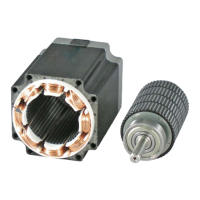Hardware Description
24 November 4, 2009
Control Interfaces (Schematic Page 4)
The Stepper RDK has three power supply rails. The input power source is used directly to provide
motor power and has a wide operating range. The exact supply voltage is not critical because the
chopper control maintains constant motor current. Unregulated supplies can be used successfully.
The microcontroller can monitor the input voltage level using a simple V
sense
circuit, however, this
measurement is not needed for the chopper control algorithm.
A simple step-down switching regulator directly generates 3.3 V for the microcontroller. The +15 V
gate driver power supply comes from a second stage boost converter, in this case a FAN5331
device from Fairchild semiconductor.
Finally, a FT232RL device provides a USB virtual COM port. The virtual COM port is a fast and
reliable method of communication between the motor control board and the RDK GUI software.
The protocol description can be found in the Software Reference Manual and could be used as a
general purpose control method from other hosts.
Software
The Stepper Motor Control RDK software manages four primary functions:
Motor current control: Real time chopper control of motor current
Motor step sequencing: Controlling the stepper motor’s commutation sequence
Motor velocity and position control: Calculates motor speed as it advances to a new position
Serial communication: Command and measurement exchange with host device
The user can add software to implement additional functions that take advantage of the unused
microcontroller peripherals or integrate the stepper control code with a custom application.
Chopper Control
Figure 3-3 shows how the chopper waveform is generated. GPIO signals from the microcontroller
turn on the MOSFET switches, causing the motor current to start to build. The rate of increase in
motor current is dependent on motor characteristics, motor load, and the supply voltage. Once the
ADC detects that the current has exceeded the threshold, a blanking time commences. The
blanking time allows the current to collapse slightly before the cycle repeats.

